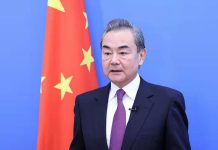BEIJING: The year of 2021 will be critical for the whole world that is struggling to end the COVID-19 pandemic and committed to addressing its long-term impacts.
The pandemic has taken a heavy toll on the world economy, disrupted globalization, amplified unilateralism and accelerated a crisis in international cooperation. To tackle those challenges will not be easy, and requires collaboration across ideologies, cultures and governments.
RAGING PANDEMIC IN U.S.
In 2021, the ravaging pandemic is still one of the most threatening challenges facing the U.S. government.
In a country that boasts the most advanced medical technology, some 21.5 million people have been infected with the virus and more than 364,600 lost their lives.
Anthony Fauci, the nation’s top infectious disease expert, has recently warned that without substantial mitigation, the middle of January could be a really “dark time” for Americans.
One of the major problems exposed in the country’s fight against the pandemic is its lack of a unified response on the national level, said Da Wei, a professor with China’s University of International Relations.
Pulling out of the World Health Organization at a critical juncture in the global fight against COVID-19, Washington has fallen further into the quagmire of unilateralism. In 2021, it remains uncertain whether the incoming administration can truly bring the country back to the track of multilateralism.
ECONOMIC RECOVERY IN EUROPE
A COVID-19 resurgence has been unleashing more uncertainty into Europe’s economic recovery, as the European Commission predicted that output in both the euro zone and the European Union (EU) is “not expected to recover its pre-pandemic level in 2022.”
Meanwhile, multiple statistics showed that countries across Europe suffered a surge in non-performing loans, bankruptcy filings and unemployment rate, prompting governments to take measures to stabilize economies and ensure people’s livelihood.
The EU has been paving the way for the implementation of a recovery package totaling over 1.8 trillion euros (2.19 trillion U.S. dollars) to handle the socio-economic consequences of the pandemic. Against such a bleak backdrop, economic cooperation between China and the EU has sustained momentum and kept pacing to a broader stage, with more opportunities sprouting after the completion of China-EU investment agreement negotiations and the entry into force of the China-EU agreement on geographical indications in 2021.
OPTIMISTIC OUTLOOK FOR ASIA PACIFIC
A new wave of infections has hit many countries in the Asia-Pacific region, indicating that combating the pandemic and managing its economic impact will remain a major challenge for the region in 2021.
Fortunately, with an array of deals having been sealed, countries have strengthened regional economic cooperation to jointly reverse the economic downturn.
The Regional Comprehensive Economic Partnership, a free trade pact signed in November, is widely believed to become a key driver to reboot regional economic growth in the post-COVID-19 era. Economic activity in developing Asia is forecast to pick up to 6.8 percent in 2021 as the region moves toward recovery from the pandemic, according to an Asian Development Bank report released in December.
In particular, China has managed to control the outbreak and achieve a strong economic recovery, injecting vitality into the economies of Asia-Pacific countries with close ties with China. In 2021, China’s role in stimulating the regional economy is expected to become more prominent. – Agencies






